Page Titles
Page Titles
Table of Contents
- What Is A Page Title? - 1 min
- How Can You View Page Titles? - 1 min
- Why Are Page Titles Important? - 2 mins
- What Is The Maximum Length Of Page Titles? - 2 mins
- How Do You Write A Great Page Title? - 8 mins
- What Is The Best Structure For Page Titles? - 3 mins
- Why Does Google Change Your Page Title In Their Search Results? - 2 mins
- What Tools Can Help You Write Page Titles? - 2 mins
- Final Thoughts - 1 min
Writing a good page title is an essential skillset for anyone in SEO, as they help both users and search engines understand the purpose of a page.
In this guide we take you through the fundamentals, as well as more advanced considerations and tactics when analysing, writing and optimising the humble page title.
What Is A Page Title?
The page title, often referred to as the ‘title tag’, ‘meta title’ or sometimes ‘SEO title’ is an HTML element in the head of a webpage that should succinctly describe the content and purpose of the page to users and search engines.
Page titles are used by search engines more than 80% of the time for the titles used in their search results.
Code Example
The page title element should be placed in the head of the document and looks like this in HTML:
<head>
<title>This Is A Page Title</title>
</head>
Page Title Length
Google can use page titles for the title used in its search results. It truncates the length of them based upon a pixel width limit, rather than character limits.
As a general rule of thumb, the optimum page title length should be between 30 and 60 characters.

This will avoid the majority of titles from being cut off, while making the most of the space available. You can read more about page title length later in this guide.
How Can You View Page Titles?
Browser
The page title is shown at the top of a browser window.

View HTML Source
Titles can also be viewed in the HTML using a browser. In Chrome, you can right click on the web page and choose ‘view page source’ to view the raw HTML, or ‘inspect’ element to view the rendered HTML.


CMS
They can often be viewed within CMS, such as WordPress which has various plugins such as Yoast SEO, which allows you to view and set page titles (shown as ‘SEO Title’ below).
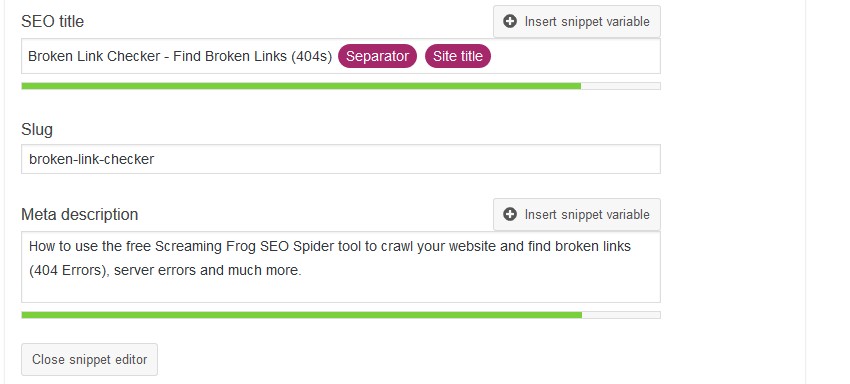
SEO Spider
Finally, they can also be viewed and analysed in bulk in an SEO crawler, such as our own SEO Spider software.
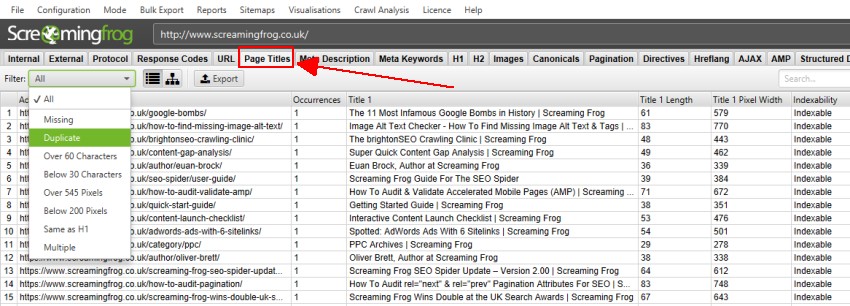
You are able to crawl the website, and look at the ‘page titles’ tab, which displays all pages, their page titles, respective lengths and helps you filter for common issues discussed later in this guide.
Why Are Page Titles Important?
Page titles are read and used by both users and the search engines to understand what a page is about. They are important for search engine optimisation (SEO) as page titles are used in rankings, and vital for user experience, as they are displayed in browsers, search engine results and on social networks.
1. Page Titles In Search Results
Page titles are used more than 80% of the time by search engines as the clickable title in their search results as shown below.

This makes them vital for communicating to users what the page is about and enticing them to click on the result over the competition.
There is continuous debate within the SEO industry as to whether click through rates (CTR) are used as a ranking signal. Regardless of whether CTR is used directly, encouraging more clicks to your website from an optimised page title is a no-brainer.
2. Page Titles & SEO
Major search engines like Google will use the words within a page title to help rank the web page for relevant search queries within their web index.
While Google in particular use hundreds of signals to score their search results, the keywords used within the page title element have greater weight in search engine ranking than general words on the page.
Industry surveys show they are widely considered to be one of the strongest on-page ranking signals for a page, which makes them essential for SEO.
3. Page Titles In Browsers
The page title is shown at the top of a browser window, such as in Chrome below:



They can also be used by browsers to prefill the messaging used for bookmarks.
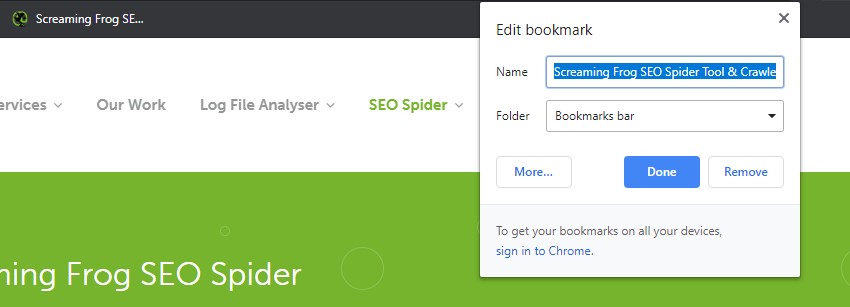
Both of these help users quickly identify and keep track of the page.
4. Page Titles In Social Networks
Some major social networks allow you to specify titles and descriptions using their own meta tags, such as Facebook with Open Graph tags and Twitter using Twitter Cards. These are different to the page title element.
However, when they are not specified using their own tags both Twitter and Facebook will use page titles as the clickable title when content is shared across their platforms. Other social networks also rely on page titles entirely.
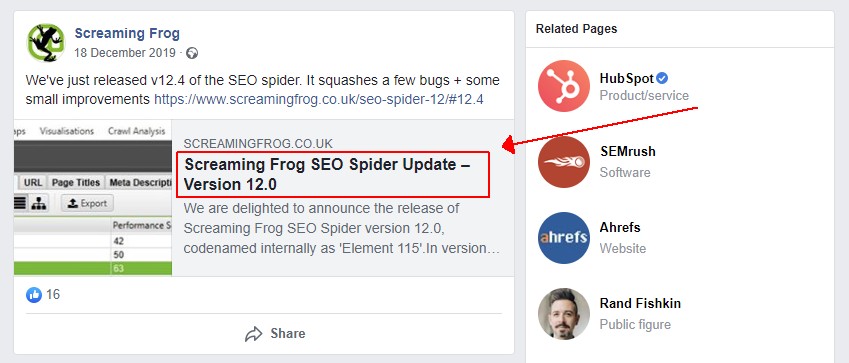
Having a great headline when your page is shared will improve the CTR significantly.
What Is The Maximum Length Of Page Titles?
There is not an exact character limit before Google truncates page titles in the search results. This is because it’s cut off point is based upon pixel width. A letter such as ‘w’ is wider than ‘I’, so depending on what’s used – some titles can have many more characters.
Google will truncate any title over this pixel limit, cutting off at whole words and display an ellipsis (” …”) to the user.

There isn’t a minimum length either, but very short page titles can mean that valuable space is wasted.
Page Title Length Best Practice
Google typically displays between 50 and 60 characters in the search results based upon it’s pixel cut off point of around 580 pixels in the desktop results.
In mobile results, the cut off point is around 485 pixels, but the font size is smaller. This means there is more space on mobile and character counts are generally longer, so using desktop page title limits as worst case scenario is generally recommended as below.
- Title Maximum Length – 580 pixels or 60 characters.
- Title Minimum Length – 200 pixels or 30 characters.
Moz research suggests that approx. 90% of your page titles should be displayed fully if they are kept within these thresholds above.
While the best practice above is very much focused upon Google, they are also valid for Bing and Yahoo which recommend up to 65 characters, as well as Duck Duck Go.
Both Yandex and Baidu display longer titles than Google, somewhere between 70-80 characters.
How Do You Write A Great Page Title?
There are few quick wins in SEO, but crafting unique, descriptive and compelling titles from poorly targeted titles can make a significant impact in organic visibility. They can help target the right keywords, increase click through rates (CTR) in the search results and help users.
Page Title Best Practices
The perfect page title typically follows these 6 rules, which can be tricky to get right for every page.
- Concise
- Descriptive & Relevant
- Unique
- Includes Brand
- Optimal In Length
- Enticing
Let’s consider each best practice rule further.
1. Page Titles Should Be Clear & Concise
Page titles should be concise, easy to scan and understand. Write for your customers first and foremost.
- Page titles shouldn’t be stuffed with keywords, or repetitive variations such as ‘Keyword 1 | Keyword 2 | Keyword 3’ etc. They read badly, and it’s unnecessary as search engines understand synonyms and related words.
- Titles should be title case, using capital letters for principal words. Avoid capitalising every word, or lowercasing the entire title.
- Be consistent. If you use word separators, use the same ones – don’t switch between hyphens, dashes and arrows constantly. Keep a consistent format and order.
- Avoid repeating the same word separators such as hyphens or dashes. Use them once, or twice – anymore can reduce readability.
The Lastminute.com page title example below is quite clear to read, however it does repeat keywords with ‘Flights to New York’ and ‘Cheap New York Flights’.

In this scenario, you could consider adjusting the title to a single ‘Cheap Flights To New York’, which would cover targeting both keywords and leave space to communicate a USP or call to action.
2. Make Them Descriptive & Relevant
Page titles should be descriptive and relevant to the content on the page. This helps the search engines better understand and rank the page for the right queries. So use descriptive keywords identified by keyword research to help target search queries.
- Avoid vague or unhelpful descriptors like ‘Home’ for the homepage, or ‘Services’ for a service page.
- Perform keyword research using tools like Google’s keyword planner to identify relevant relevant keywords that users will type into search engines. Group the keywords into topics, and map them to relevant pages.
- Consider the intent behind the query of the search. What does the user actually want? Is it an informational query, or do they want to buy? Analyse the search results for the query and ensure your page and title matches the intent for the target keyword and query.
- Choose relevancy over search volume in targeting. Use words that match your content, business, service or product the best. If you’re a local business, consider including the region you’re targeting.
- Prioritise one or two of the most important keywords to include in the page title for each page. Use relevant modifiers or calls to action alongside the primary target keyword(s). Calls to action may include ‘Buy’, ‘Download’, or ‘Trial’ while modifiers might include ‘Guide’, ‘Online’, ‘Quotes’ as examples.
- Ensure your page titles are a true representation of the content on the page. Avoid the temptation of using keywords that are not entirely relevant, as users will bounce quickly and search engines like Google evaluate user signals and demote the ranking of under-performing pages with negative signals.
An example of query intent and keyword targeting is ‘search engine optimisation’ and ‘SEO’.
If you analyse the search results and content already ranking for ‘SEO’, it clearly highlights the results are informational. The results appear to answer the question ‘What Is SEO?’.
So Google believes this to be the real intent behind the query and is returning guides and resources which answer the question. Google does not want to rank ‘SEO services’ pages for this query, as that’s not what users want to see. So the type of content and keywords you target will need to match to rank for this keyword.
3. Ensure Every Page Title Is Unique
It’s really important to have distinct and unique page titles for every page. If every page has the same page title, then it can make it more challenging for users and the search engines to understand one page from another.
- Avoid using the same keywords across many pages. This can confuse users, and search engines when picking the best page to rank for a query.
- Map target topics and keywords to pages across the website, and consider as a whole to ensure page titles are unique and they don’t compete.
- For large websites, it’s unrealistic to craft bespoke page titles for every page. So use templated page titles and dynamically change elements to make them unique. For example, ‘Buy <Product> from <Price> with Free Delivery | Brand Name’ where only the ‘Product’ and ‘Price’ are unique.
- If pages are unique, have value and should be indexable, then they should be able to have a unique page title. If you find this hard as they are very similar to another page, then consider whether they are really a duplicate or near duplicate content that shouldn’t be indexed.
As an example, flight providers have location pages, but will also have pages ‘from’ each location and airport they fly from and to, which can create lots of closely related pages.
In the screen grab below the company has included ‘From <Location>’ and <price> to ensure they are unique and useful to the user who is interested in specific flights near them.
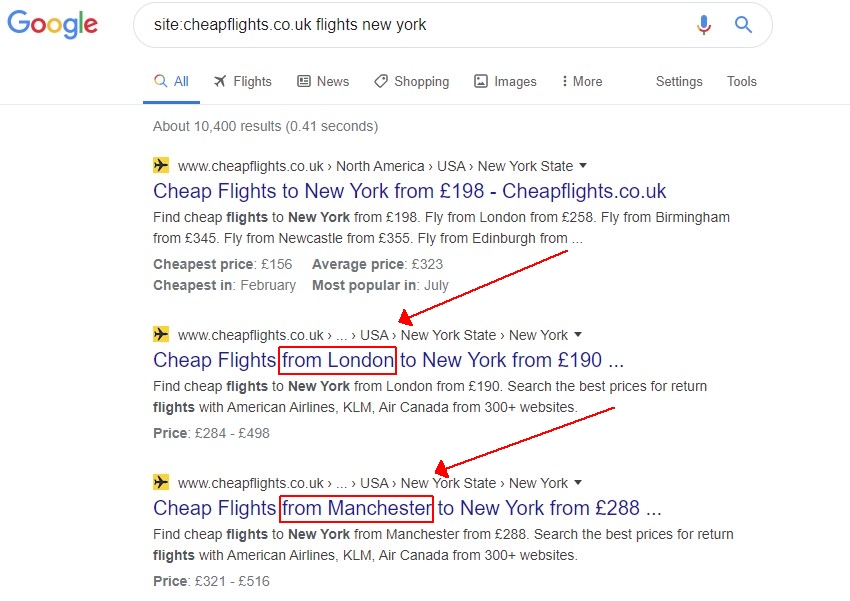
4. Include Your Brand
If you’re a known brand then include it in page titles to help differentiate you from the competition and increase CTR. If you’re relatively unknown, including your brand can still help raise awareness and be useful to the user.
- Include your brand either at the start or the end of the page title, separated from the rest of the title with a delimiter such as a pipe or hyphen.
- When using your brand name, use your preferred name and not variations such as ‘Screaming Frog’, ‘Screaming Frog Ltd’, and ‘ScreamingFrog.co.uk’ randomly.
You can of course choose not to include your brand in the page title, but you may find that Google rewrites it to include your brand. More on this later.
5. Optimise Page Title Length
If your page titles are too long, they will be cut off or not used at all by search engines. This could mean important keywords or information is not seen by users in the search results.
- Front-load important keywords in your page title, so they show in the search results before word truncation at around 580 pixels or 60 characters. Keywords at the beginning of a title may carry more weight.
- Don’t stress if some of your titles are over the limit or some less important words are truncated by the search engines.
- There’s no ‘minimum’ required length. However, use the available space wisely. Short concise page titles are great for users and search engines, but you might be missing an opportunity to be more descriptive or target additional keyword modifiers if titles are consistently below 200 pixels or 30 characters.
6. Encourage Clicks By Making Them Enticing
Your page titles have to make people want to click them. The more appealing they are, the higher the CTR and the more traffic they will drive.
- Make your titles stand out in the search results over the other competition on the page. This is often easier for article content, over say ecommerce product pages. For ecommerce it might be a price point, discount, free delivery or another a USP. For an article it could be including a number like ’50 Killer Ways To X’, a date such as ‘Best X in 2020’ or using an emotional hook like ‘Why The New iPhone X Sucks’ that help you grab peoples attention.
- SEOs and webmasters regularly find different ways to stand out, like using emojis in titles. These often work for a short-period, before being filtered out by Google to keep the search results less cluttered.
- If you’re struggling to include target keywords and make the page title stand out from the competition within the length limits, then use the meta description to stand out instead, as it has more space to include detailed USPs, benefits or calls to action.
A search for ‘cheap holidays’ is an excellent example of businesses aggressively competing for eyeballs with various call to actions.
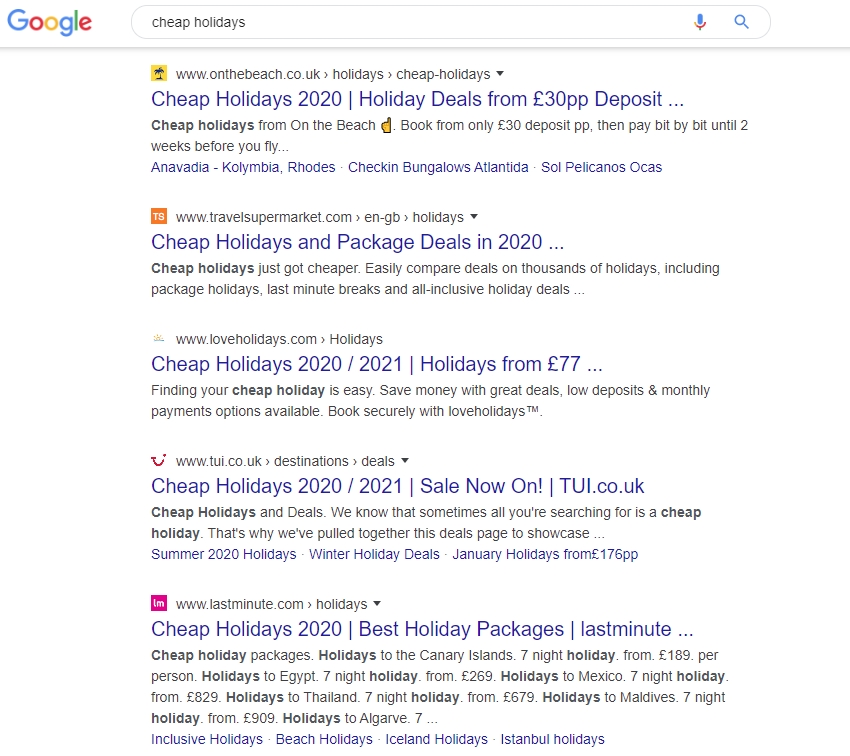
What Is The Best Structure For Page Titles?
Page Title Format & Order
Keep a consistent structure and format across page types. Relevant keywords matching the search query should be visible to the user in the search result, and keywords at the beginning of a title might carry a little more weight.
Therefore, the following page title format and order often works well for businesses selling a product or service.
<Target Keyword(s)> <Modifier(s)> <USP> | Brand Name
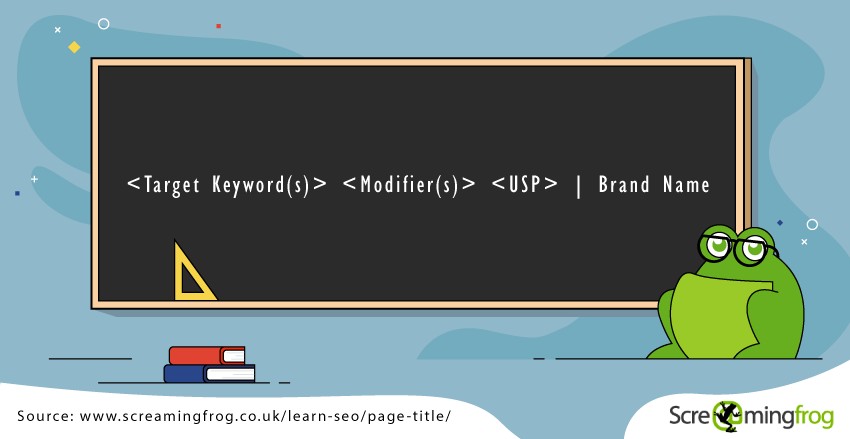
This order doesn’t have to be fixed, and various combinations of the above work fine. For example, you could include some modifiers before the main target keyword if the title reads better for the user, or remove a USP if there isn’t enough room.
Below is an excellent page title example from Admiral.com, which have a succinct title targeting ‘car insurance’, includes the ‘quotes’ modifier, as well as a price and brand.

Title tags for articles can often be crafted far more naturally with the user in mind.
Page Title Separator
What’s the best separator to use in page titles? The answer is, it really doesn’t matter. Use what works for your readers, and keep it consistent.
The two most common forms of word separators are pipes (|) and hyphens or dashes (-). Pipes use the least pixel width, so are generally a preferred delimiter.
A quick list of page title separators include:
- Pipe |
- Hyphen –
- Colon :
- Tilde ~
- Star *
- Less Than Sign <
- Greater Than Sign >
Why Does Google Change Your Page Title In Their Search Results?
There is no guarantee that Google (or other search engines) will use your page title as their title in the search results. Google will choose to use a different title less than 20% of the time.
Google can choose to re-write your title using content from the page (such as headings, or on-page text), or words used in internal or external links that better represents the document overall.
When Google rewrites page titles, they are far less query dependent. This means that Google will generally use the rewritten title they believe is best for the page, for all queries for that page.
Google rewrite titles for a number of reasons:
- Content from the page better matches the relevance of the page than the title. This can occur even for fairly concise and descriptive page titles.
- The page title is not descriptive or boilerplated.
- The page title is stuffed full of repetitive keywords.
- The page title is really long.
- The page title doesn’t include the brand, and Google has modified it to include the brand.
- You have an alternate Facebook or Twitter title that Google has decided to use, as it’s more relevant than the existing title element.
- The page is blocked by robots.txt, which means the title can’t be seen by the search engines. URLs can still be indexed, and often anchor text is used to formulate the best title for users to their query.
There is no way to force Google to use your page title. However, writing more relevant titles that better represent the page help make them appear more frequently.
What Tools Can Help You Write Page Titles?
A mixture of keyword research tools, SEO crawlers and page title emulators should help you experiment and craft the perfect page title.
Keyword Research
Use the following tools to perform keyword research around relevant topics and keywords.
Analysing Page Titles
Our Screaming Frog SEO Spider software can help you view and analyse your page titles. Just download the tool, and crawl 500 URLs for free (or more with a licence) and click on the ‘page titles’ tab.

This will display all pages, their page titles, respective lengths, pixel widths and it will help you identify common issues such as missing, duplicate, long or short titles that can be optimised.
Page Title Emulators
The SEO Spider also has a SERP Snippet emulator, which allows you to see how your website may appear in the Google search results. It uses the latest pixel width cut off point and counts the number of pixels used in page titles and meta descriptions for every character to show an emulated SERP snippet for greater accuracy.
The current limits are displayed under the page titles and meta description tabs and filters ‘Over X Pixels’ and in the ‘available’ pixels column below.
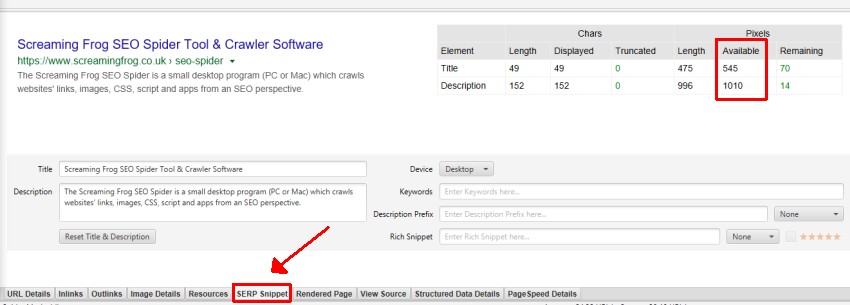
You’re able to perfectly craft your page titles and meta descriptions within the tool, before exporting and sending to a dev team to make the changes to the live site.
The Yoast SEO plugin available for WordPress also has a page title emulator which can help when writing titles.
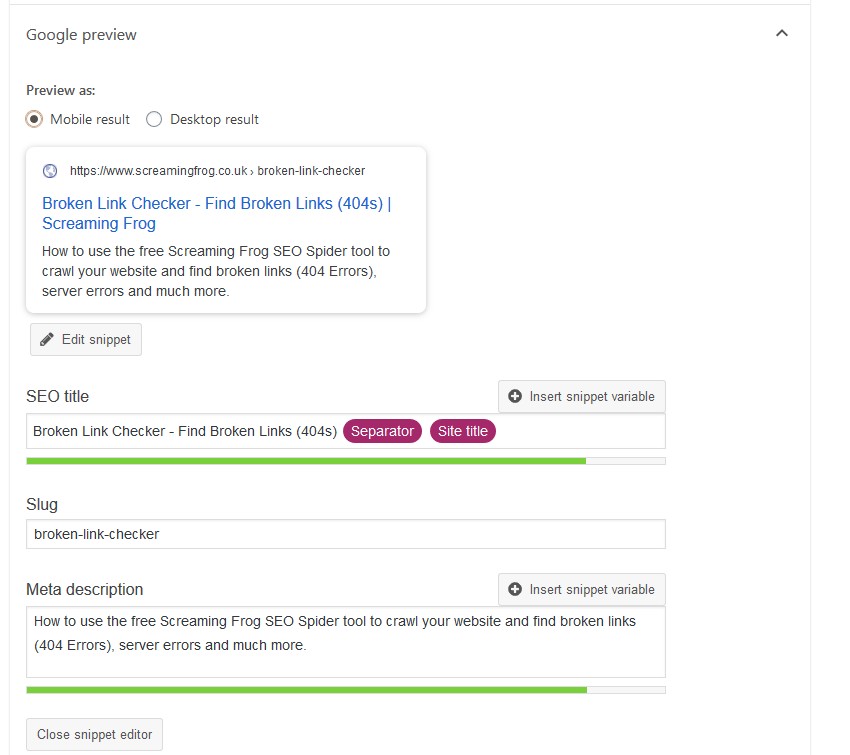
Final Thoughts
Improving title tags is relatively simple, but it can take time and effort to craft them.
With the right budget and resource, you can evaluate, optimise and test page titles as part of an ongoing process to refine targeting and improve organic CTR.
CTR of pages can be analysed using Google Search Console and those with low click through rates are ideal candidates for improved titles. You can even split test title tags to see which perform the best.
For many this will be too advanced and laborious, and just having descriptive and unique title tags is a step forward.
Further Reading
- Create good titles and snippets in Search Results - From Google
- Bing Webmaster Guidelines - From Bing





